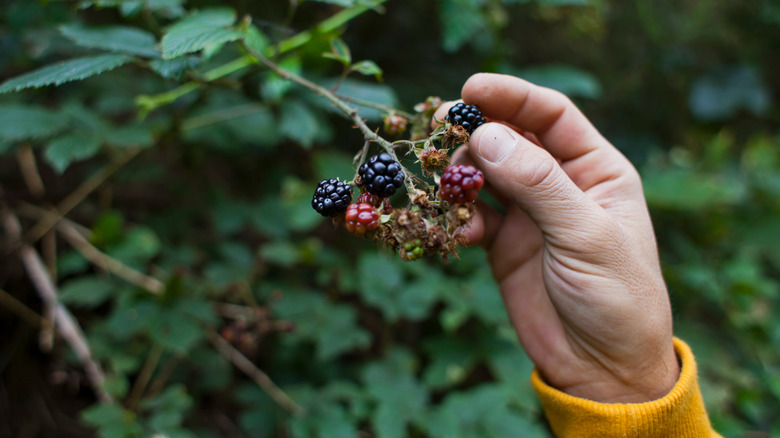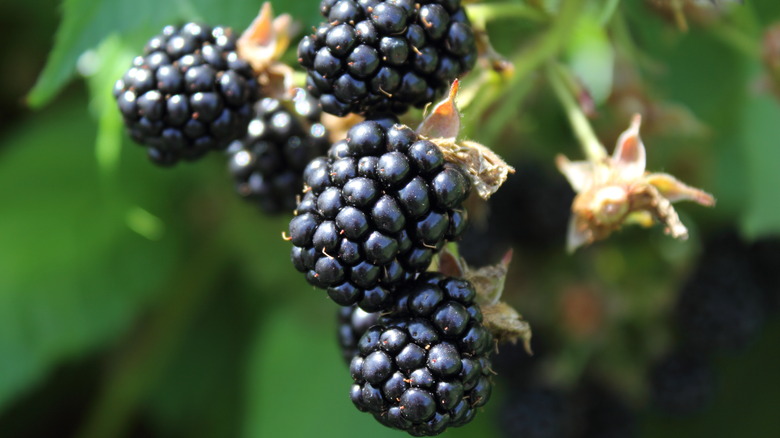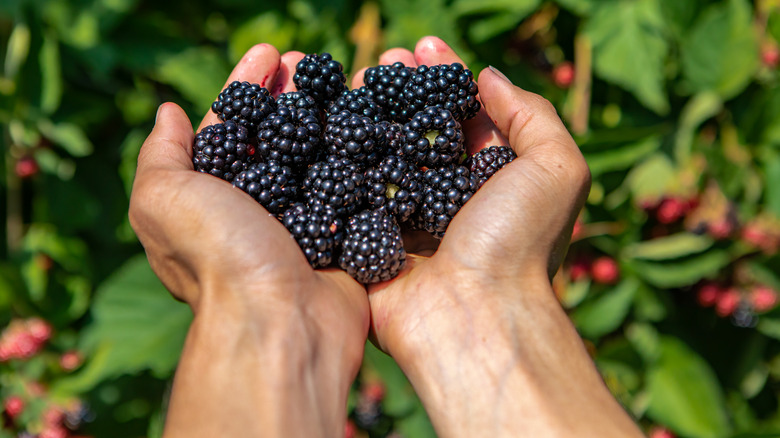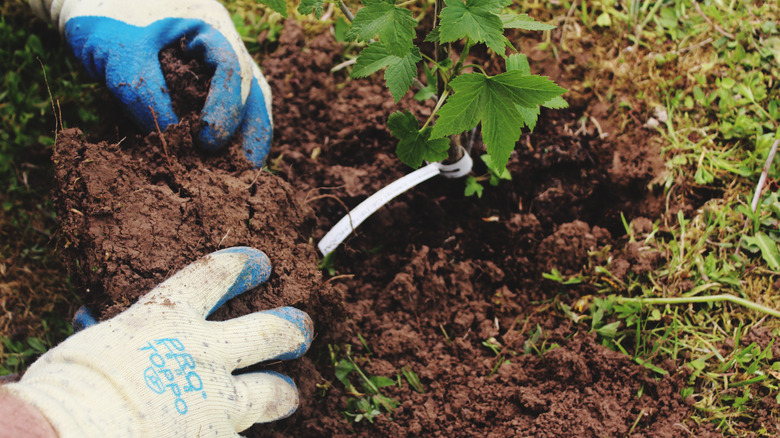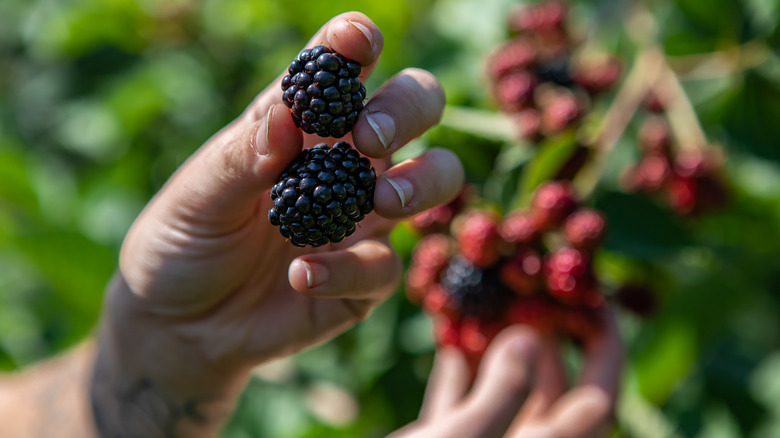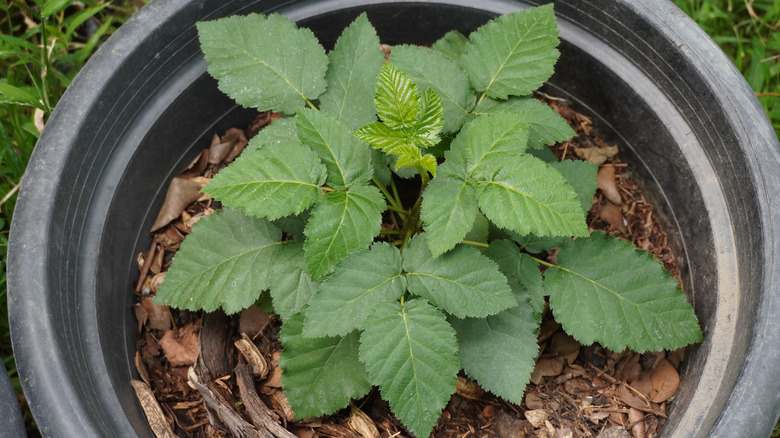How To Grow And Care For A Blackberry Plant
It's something of a family ritual, like the clambake on the beach or a backyard barbecue, to stop and pick blackberries along a rural roadside. They're delicious right off the vine and a perfect ingredient for baking or to use in syrups, jams, jellies, or smoothies. But plucking them by the side of the road often comes at a price, as the thorns on their bushes can make you pay dearly for every sweet bite.
Blackberries from the family Rosaceae, known as Rubus fruticosus, are now available in thornless cultivars you can grow on your own. Native to America, most varieties of these bramble family members prefer climates where the days are warm and the nights are cool.
Blackberries are not actually berries at all; they're part of a larger family that includes roses, and their aggregate fruits are comprised of flavor-packed compartments called drupelets, per Gardeners Path. They're also perennial plants and most often categorized by their growth habits, according to Garden Guides. They can be trailing, semi-trailing, or erect. The erect variety grows upright, requires no support, and is more tolerant of cold weather. It's also the variety that produces thorns. Not all erect blackberry plants have them, but if there are thorns visible, you now know you're looking at an erect blackberry plant. Both the other varieties will require trellising to stand up.
How to use blackberries in your garden
People don't generally boast about the beauty of their blackberry plants. It's not that they're ugly; they're just utilitarian. They're grown to produce fruit and are never more attractive than when they're laden with ripening berries on the vine.
As head of the University of Arkansas blackberry breeding program in Fayetteville, John Clark explained to Fine Gardening that the flavors of the berries you pick are very much a byproduct of their genetics and appear across the spectrum from tart to sweet. Most of the eastern upright varieties are on the sweeter side, while those that hail from the Pacific Northwest are generally less so.
Clark adds that thorn-free varieties literally make for easy pickings, and their berries are usually more firm and do better in storage than their thorny relatives. Secondarily, some strains of blackberry bushes are very invasive, and the thornless variety is decidedly less aggressive about conquering your backyard. One big drawback to the thornless plants is that they're not quite as hardy.
How to grow blackberries
Growing blackberries isn't complicated. They do best in soil that's on the acidic side, although they've been found in unlikely spots. Blackberries can be grown from seed, but most agree that's doing things the hard way.
The most trouble-free method is to purchase a young plant or root from a nursery and simply place it into prepared soil. You could also obtain a cutting or a tip root of the vine. Because these plants send out roots wherever their vines touch the ground, it's best to get a cutting without flowers or fruits and plant it anew. You'll want more than one cutting to maximize your odds of success, and each should be between four and six inches with leaves plucked from the bottom two inches or so.
Winter's end and the early days of spring are prime planting times, and you'll always want to get your plant into the ground immediately after taking possession. Soak the rootball in tepid water for a couple of hours as you prepare to plant. It's best to create a trench-like site that's roughly eight inches in width and two or three inches deep, so there's ample room for its roots to spread. Blackberries are a cane berry with shallow root systems, so they won't need anything deeper. Manure or compost helps, as will spreading the roots by hand. Then backfill the hole and give the plant a thorough watering, per Gardeners Path.
Caring for a blackberry plant
One blackberry plant can provide decades of harvest. But for that to happen, you'll want to offer an assist by providing the best environment possible, and getting the right pH balance in your soil is vital. If you don't know whether your soil is acidic, neutral, or base, a quick Internet search will identify places that will test your soil for a pittance.
The second crucial component is making sure your plant is getting the water it needs. With blackberries, that's pretty simple. Gardening Guide says to water them once a week, then monitor the plant's health. As you get more rain, you'll need less water. Likewise, you'll want to make sure your plant has access to plenty of direct sunlight — eight hours a day at a minimum.
Because blackberries can be invasive, keep an eye on what's planted nearby. Pruning helps keep the plant healthy and clear of dead stems and leaves, but remember that less is more; you don't want to inhibit plant growth. Going in manually, while remembering those thorns and that blackberries leave stubborn stains, to prune twice a year at season's change is highly recommended.
Then harvesting the berries becomes the fun part of the job — unless you've opted for the sweeter and more savage varieties with lots of thorns. Thick gloves, thick clothes, patience, and luck will all come in handy here. The berries are ripe about a week after you start seeing them appear.
Varieties of blackberries
While blackberries are distinguished according to their growth patterns — erect, semi-erect, and trailing — there are hundreds of different hybrids and species. Here are some common blackberry varieties.
- Primocanes: These plants are new canes that grow from the crown or roots and appear each year to provide new fruit. Home Guides points out that yet another way these cultivators are identified is as primocane-fruiting.
- Kiowa: This is the best known of the major strains of blackberry plant, which earns its popularity from its naturally large and tasty fruit and not from the spiky thorns it uses to keep animals (including us) at bay per Fine Gardening.
- Himalaya: If you're looking to bring a wild blackberry plant home, be aware that you just might be asking for trouble. Most blackberry plants also share round stems, but one of the most invasive species, Himalaya, has five-angle ridged stems — so they're easy to spot. They also share five leaflets whereas most others only produce three, explains Garden Guides.
- Ouachita: Over time, horticulturists have worked their magic on the plant, resulting in new thornless varieties, such as Ouachita.
- Natchez: Another thornless variety, these have been modified to produce bigger fruit than their thorny relatives, per Gardening Know How.
Repotting blackberry plants
Let's say you've been warned enough about thorns and plant home invasion. There is a great option that can still give you access to those fresh blackberries you crave. You can grow them in a container.
Gardening Know-How provides a straightforward guide, including recommendations about which varieties do well potted. Among them are the Arapaho, Triple Crown, and Kiowa. The instructions or your seller can explain whether your variety will need trellis support.
First, select a container that's at least eight inches deep (some say 12 to 13 is optimal) with room for six or more inches of filler. These plants' roots reach out and not down, so you won't need the deepest container. What you will need is enough space for your canes to do their work.
Place your plant in the center of a six-inch deep hole created from a mixture of soil and organic compost that's balanced to a level of 5.5 pH. Backfill and water the plant until you are sure it's moist to your first knuckle. Give the plant full sun and an inch and a half of water a week for the first year. Trim the canes to 18 inches in the spring of the second year, and once the second fruiting is complete, you can trim away dying canes at the crown of the root and repeat that process annually. Continue to test the soil to be certain that the pH of your soil remains between 5.0 and 6.0.
